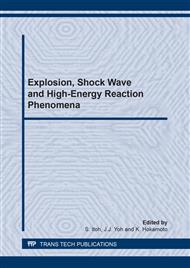p.167
p.173
p.179
p.185
p.191
p.197
p.203
p.209
p.215
Explosively Driven Fragmentation Behavior for Structural Components and Shatterproof Effect of Wall Doubling
Abstract:
One-dimensional symmetrical explosive loadings are applied to expand structural components: tubular cylinders, spherical shells and rings of 304 stainless steel and double and single walled cylinders of an aluminum alloy, A5052 to fragmentation, and the effects of wall thicknesses, explosive driver diameters and the constant proportionality of the in-plane biaxial stretching rates are investigated on the deformation and fracture behavior of three types of single walled structures and shatterproof behavior for double walled cylinders experimentally and numerically. In the cylinder tests, the driver is a column of high explosive PETN, inserted coaxially into the bore of a cylinder and initiated by exploding a fine wire bundle at the column axis using a discharge current. In case of the ring tests, ring specimens are placed onto a cylinder charged with the PETN as an expansion driver, and for sphere tests, a specimen filled with the PETN is also initiated by exploding a fine copper wire line with small length located at the central point. Observation results of deformation have shown the final maximum in-plane stretching rate order of , and fracture evaluations on recovered fragments are discussed indicating the need of modified fragmentation model for the structural components. In the double walled cylinder tests, only for lowermost amount of the explosive the outer cylinder has almost caught the fragments of inner cylinder, revealing that the damage phenomena are much different from those for single walled ones.
Info:
Periodical:
Pages:
191-196
Citation:
Online since:
January 2011
Keywords:
Price:
Сopyright:
© 2011 Trans Tech Publications Ltd. All Rights Reserved
Share:
Citation:


